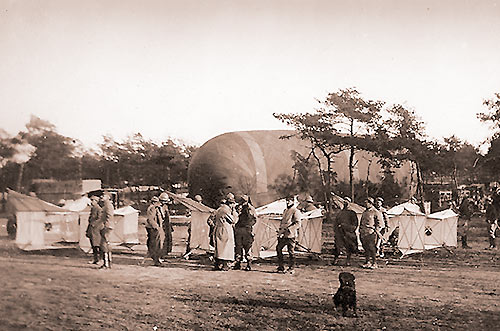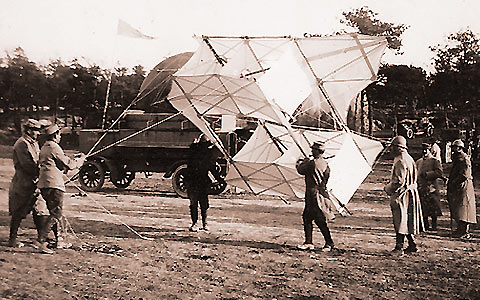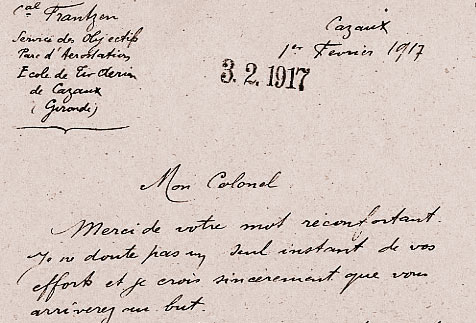| |
| Beginnings of Great War |
| |
| In the Mediterranean sea, in 1913, during maneuvers on the naval cruiser Edgar Quinet, Félix Peaucou was tie down roper : "On may 30th, off Porto-Vecchio (Corsa) where the squadron was on release, the kites made quite an attraction. The evolutions occurred during a nice sunny day, but under a light breeze (about 3 to 4 meters per second). We were about to see the advantage of maritime kites over land kites, as we just needed to build up that missing speed with the boat. |
| |
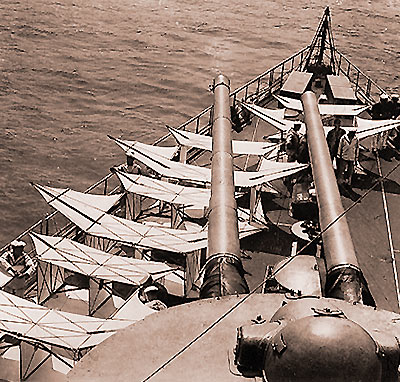 |
The Edgar Quinet, commanded by Vessel Captain Héritier, got the order to run at full fire, which meant a speed of twenty one knots. A team of sailors, guided by the land kite team, better trained and used to the quick and delicate kite maneuvers, immediately undertook the task. |
| |
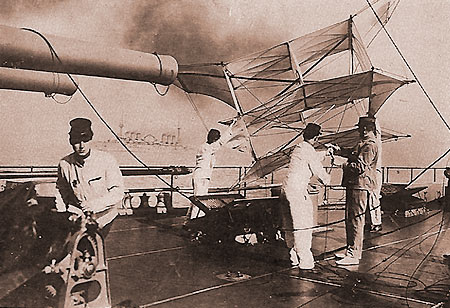 |
| |
The kite assembly and launch occurred, of course, on the rear deck of the ship. Just behind the steering compartment and between two twin 194mm turrets. The automotive winch was replaced by two separate electric winches, but designed the same way, in order to pull the cables in or unwind them. The operations were under the complete control of captain Saconney, assisted by lieutenant Cholley who made the first ascension.
Superior officers of the Navy expressed the desire to taste the little known feeling of a kite lifting. All declared a total enchantment upon their return, generously congratulating the maker of that aerial observation method." |
| |
| The Great War |
| |
Saturday, august 1st, 1914; informed of the German war declaration to Russia, France declares general mobilization at 4 pm. On August 3rd, Germany declares war to France.
When war broke out, the telephoto laboratory is organized into three sections installed at Toul, Verdun and in the entrenched camp of Paris. Each has a small team of three people - an officer, a designer and a photographer - with all in all two cameras and some equipment for development.
Kites and tethered balloons are then considered platforms suitable for aerial photography. From the first hours of the conflict, the idea of taking photographs from an airplane reappears. Thus, 2 August 1914, the Director of Aviation of the 1st Army reported that the presence of the Captain Saconney, Director since November 1912 of Aerology laboratory and telephoto at Chalais-Meudon, proves "indispensable to the interpretation of photographic prints." So he asks incorporation of Saconney and his team of aerial photography kite and captives balloons Aeronautical armed 1st in Epinal. |
Thus, Captain Saconney, based in Epinal, obtained permission to work for the 1st Army organizing a balloon and kite automobile section.
He uses the spherical balloon old field companies (model 1876), Motor winch for operating trains kites, trucks and buses for staff, allowing him to travel every day from 20 to 40 kilometers from his place of employment.
But he is obliged to return nightly to Epinal with his team, otherwise they might be were considered deserters.
Saconney is not only the organizer, but also the only observer.
By more than 10 meters per second wind, He uses a kites train to make his observations. |
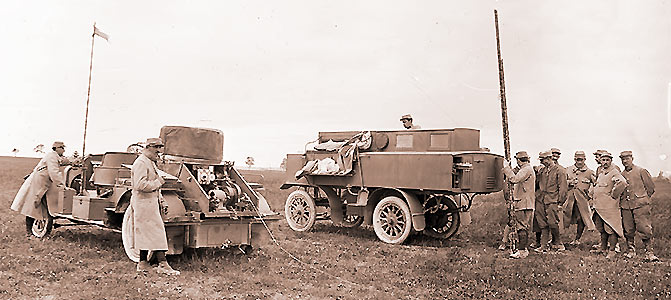 |
| |
|
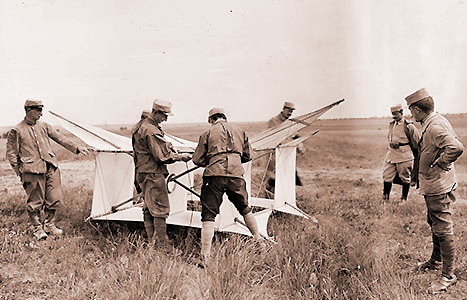 |
On 28 August 1914, Saconney moved on Mortagne (40 km from Epinal). With his company, he travels the eastern front for 14 days, by phone connects with the first heavy guns, deciding firing, locate the enemy's batteries, reports of troop movements, monitoring convoys on the roads.
His observations are transmitted by relay runners and telephone connections are established.
But facing the german progress, the company folds back and is posted on the front that runs from Vic-sur-Aisne (Aisne, France) and Furne (Belgium), on September 27th, 1914.
A second company, the 30th, created later, also makes aerial observations by both balloon and kite. This 30th company Saconney leaves the eastern front to go make up the North Sea.
From September 27th 1914 to February 10th 1915, the 30th company of Captain Saconney accumulates a total of 172 hours of observation, 48 of which were done with kites; and 114 with spherical balloon, allowing the discovery of 80 artillery units, 67 shooting adjustments. |
| |
|
| As for the 39th company itself, it deserves a quotation in April 1915, stating : "… did not hesitate, twice, to take their balloon and kites in very short range of the German front, to better help in aligning the aim of our artillery." At that time, of the 94 aerostation companies, about ten were equipped of a kite section. |
| |
| Lucien Frantzen, wounded, is transferred to the Cazaux shooting school (Gironde, France) in the service of aerial drone towed by kite. on Right, below : Extract from the letter of Frantzen to his kernel, upon arrival in Cazaux. |
| |
| Decline in the use of kites |
| |
| Aviation begins to give real proofs of reliability, while the efficiency of kites is now questioned. Moreover, when reading the aerostation company reports, we notice that winter 1915 is often foggy, preventing any ascension and forcing infantrymen to endure the fatal shootings of the enemy. |
| |
"The first two weeks of January have seen an even worse performance of all machines.
Weather conditions were, indeed, almost always unfavourable : frequent rain, fog, violent and unsteady winds…"
The balloon could not make any useful rise.... The kites made operations at the observation posts, for rises. A single rise allowing observations has been achieved on January 6th, on the Camblain l'Abbé road. |
 |
| |
|
| This ascension to 300m lasted only from 10h30 to 10h50 and was interrupted by the rain. During this rising, Sergeant Observer Mourtay observed German shootings and French shootings, which generated no remarks in the report. |
| |
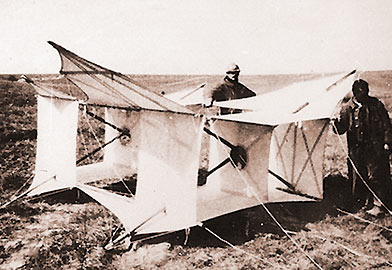 |
During the attempts on the other days, we noticed, after launching the kite train, the impossibility or the futility of the ascension.
In short, during this fortnight, there have been a presence during 11 days on the battle field, including 8 with manoeuvres and only one rising with observations" signed lieutenant commander of the 30th company of aerostation.
This harsh winter will put the use of observation kites in a vulnerable position. |
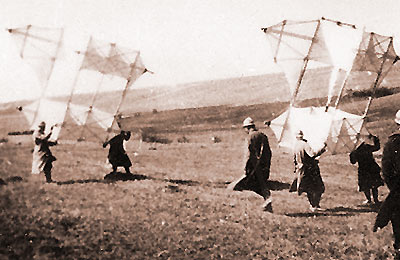 |
| |
|
| March 1916, a report addressed to the Main Head Quarter states that the kite sections do not make any more risings. Their kite winches have been taken to Chalais-Meudon to be overhauled. They will never be sent back to their companies of origin. |
| |
The balloons
The French army copies the German balloon-kite, the "Drachen", by making a 800 cubic meters model and put them in service in 1914.
Improved by Captain Caquot (700 m3), they show up at the front in 1915. Caquot then creates a 900 m3 balloon, used in 1916.
The Caquot balloon is also called 'sausage'.
1916, Saconney creates, and then manages an instruction school of aerostation and kite at Vadenay.
In 1917, he is named inspector of all aerostation companies, then Director of civil aviation in 1919.
1917, Pantenier is named chief of weather kite experimentation and construction at the Trappes observatory, where he worked for 18 months with the best specialists in meteorology.
Thus, in 1918, troops of balloon pilots are, alas, equipped only with balloons.
See report about ballon (in French at the moment) ballons d'observation de la Grande guerre |
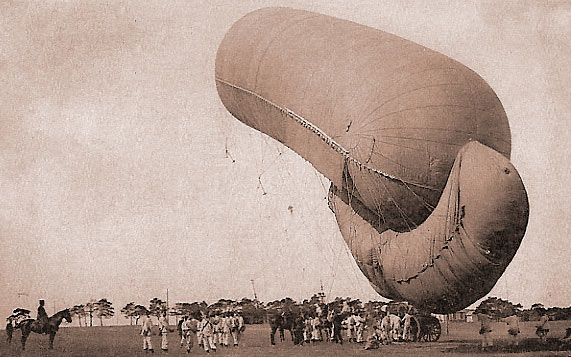 |
| |
|
|





